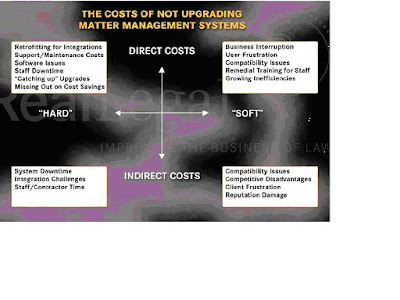When budgets are tight, firms and legal departments wisely question every expense. They often postpone technology upgrades to avoid or reduce costs. In reality, there are a number of hidden costs of not upgrading and they may end up costing more than the expected savings.
Over the course of my career, the legal profession has incorporated technology into daily life to the point that it is considered critical—and not just for billing and accounting. As with automobiles, technology today does more but also costs more than it did 5 or 10 years ago.
Technology projects and ongoing maintenance also have costs. Beware the temptation to cut them too far. When deciding whether to upgrade, look at the less-obvious costs of standing still while your competitors and partners pass you by. Total the short-term savings of not upgrading your technology and then get ready to subtract. I created the illustration below, “Costs of Not Upgrading,” for the original article, but it has been omitted from the archive version. The graph shows a number of cost items that most offices will encounter. They are categorized into direct versus indirect and hard versus soft costs.

Be sure to factor in these probable consequences of not keeping your technology fairly up to date:
1. Growing Impact of Disruptions – What does down-time cost you when an old system falters or your staff encounters incompatibility obstacles?
2. Increasing Costs of Catching Up – Are incremental costs that spread the pain over time better than a huge outlay to catch up years later?
3. Injury to Reputation and Business Development Efforts – Will your customers and future customers develop a poor impression if your technology lags?
4. Missed Opportunities to Save – Are there new capabilities available that can produce savings to offset upgrade costs?
The current economy can actually help you here. Almost every tech vendor out there now has discounts, incentives and faster delivery times than they did when business was booming. You may be able to obtain significant price concessions if you act soon and even lock them in for later. Just like major corporations today are driving deflation in their supply chains, technology customers have significant bargaining power in price, delivery schedules and other contract terms that will not be there when the economy takes off again. So much so, that a number of software vendors are giving away their software these days, according to this article on WSJ.com (subscription may be required).
Another benefit to upgrading when business is slower: less disruption to your customers and clients. Take advantage of the lull by ramping up for the chaos that is likely when many sectors take off at once later this year.
Whether obvious and predictable or more remote and intangible, there are costs incurred when not upgrading. The hidden costs of delaying upgrades can easily overcome the more apparent costs of staying current. Take another look at the project costs analysis before making that technology budget cut. Now may be the best time to boldly upgrade. The conservative mantra of “a penny saved is a penny earned” should yield to the wiser advice -- “do not be ‘penny wise’ and ‘pound foolish.’”
No comments:
Post a Comment